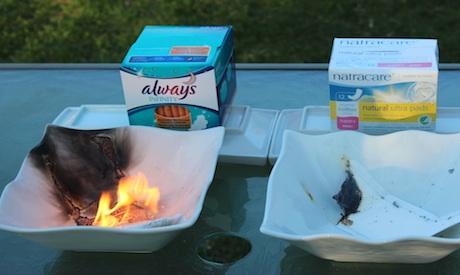[A MUST SEE! Andrea sets fire to Always Infinity and Natracare pads. The Always Infinity pad burns rapidly potentially indicating petrochemicals, plastics, and other chemicals, while the Natracare pad hardly burns.]
I’m a vigilant label reader and have been since I first began to uncover the toxic additives that make seemingly healthy food, junk food. The same is true of the supplements I take and the cosmetic products I put on my body. I’ve learned to look for dangerous chemicals disguised in harmless words like “fragrance” or “made with natural ingredients.” But it wasn’t until researching my book Label Lessons: Your Guide to a Healthy Shopping Cart (with co-author Lisa Tsakos), that I learned firsthand how tampons and sanitary pads, products that alleviate some of the confines of our monthly cycle, might actually be harming our bodies.
Here’s what I found out:
- Conventional tampons and sanitary pad companies don’t have to fully disclose their ingredients.
- Conventional tampons are typically manufactured using a blend of synthetic rayon and cotton because it’s cheaper to produce than cotton alone and it has a higher capacity for absorbing liquid. Rayon is a cellulose fiber made from wood pulp. It has been associated with Toxic Shock Syndrome (TSS), a systemic, and potentially deadly, illness caused by bacteria associated with the use of tampons. According to the Mayo Clinic:
“Researchers don’t know exactly how tampons may cause toxic shock syndrome. Some believe that when superabsorbent tampons are left in place for a long time, the tampons become a breeding ground for bacteria. Others have suggested that the superabsorbent fibers in the tampons can scratch the surface of the vagina, making it possible for bacteria or their toxins to enter the bloodstream.”
- Conventional tampons and sanitary pads are bleached using chlorine dioxide. Although the process is technically “chlorine-free,” it produces dioxins as a byproduct released into the environment. In 1998, the EPA outlawed a much more potent dioxin-producing bleaching process, and while the newer process significantly reduces dioxins, some experts believe it doesn’t eliminate them entirely from the end products. According to the EPA, dioxin exposure causes cancer in lab animals and poses a high risk to humans as well.
- Conventional tampons contain pesticides. I’ve long been wary of conventional, non-organic, foods for fear of pesticide residue. All the while, conventional cotton, the most heavily sprayed crop in existence, is used in the tampons that women use each and every month. Cotton crops make up just 2.4 percent of the world’s land, but each year a whopping $2 billion is spent on pesticides to spray this one crop. If tampons were a fruit or vegetable, they would most certainly be added to the top of the Dirty Dozen Plus™ list.
- Tampons and pads with odor neutralizers and other artificial fragrances are nothing short of a chemical soup laced with artificial colors, polyester, adhesives, polyethylene (PET), polypropylene, and propylene glycol (PEG), contaminants linked to hormone disruption, cancer, birth defects, dryness, and infertility. We are becoming more aware of the dangers associated with chemicals in everyday products including lotions, shampoos, shower curtains, household cleaners, etc. but we need to stop and think about the tampons and sanitary pads we put into and onto our bodies every single month.
- While doing our research, we found very little information on this topic. We really had to dig deep.
- In 2003, House Representative Carolyn Maloney introduced legislation that would have required research into the health risks posed by additives found in feminine hygiene products. The suspected risks included endometriosis, cervical cancer, breast cancer and ovarian cancer. This legislation didn’t pass. We recently called Carolyn Maloney’s office to inquire whether any new legislation has been put forth since 2003 and they confirmed nothing has. It’s been over 10 years since concern arose that the chemicals in tampons and pads could potentially harm women’s reproductive organs. So why wouldn’t legislation to research the issue be brought back to the table over and over again until something is done about it?
- Many conventional sanitary pads include latex, a potential allergen. Latex can be used to make the wings on pads more flexible, and it can be used as a binder on the surface of pads and liners, where it comes in close contact with the skin.
- Ninety percent of conventional sanitary pads are made from crude oil plastic. The rest is made from chlorine-bleached wood pulp. By using plastic laden feminine hygiene products, we add the equivalent to 180 billion plastic bags to our waste stream.
- Conventional tampons most probably contain genetically modified organisms (GMOs). According the USDA, 94 percent of all the cotton planted in the U.S. is genetically engineered.[1] GMOs have been linked to a host of health issues[2] including food allergies, leaky gut syndrome, and inflammation, just to name a few. By purchasing conventional tampons you are essentially supporting GMO grown [cotton] crops.
If you haven’t yet seen the GMO documentary film Genetic Roulette, I highly recommend it. I had the chance to hear the film’s director Jeffrey Smith speak in April and he showed that the evidence linking GMOs to health issues is something we can no longer ignore.
This led me to think. Is inserting a GMO tampon into your vagina several times every month any different than ingesting GMO food? According to Dr. Susan Treiser, MD., the skin around the vaginal area is highly vascular and therefore more permeable to a wide range of compounds. I am not a doctor or scientist, but logic suggests that GMOs, pesticides or chemicals in the body—from either end—can’t be good for us.




